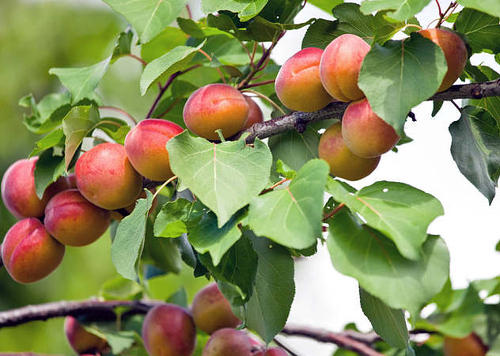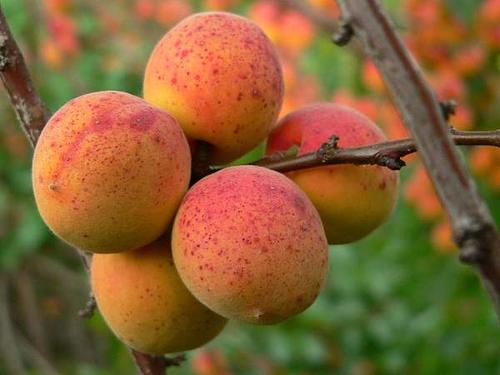Armenian plum profile
Written by Maggie
Mar 16 2021

Blooming Armenian plum flowers, colorful and charming, colorful flowers, rouge ten thousand points, accounted for the spring breeze. The garden is planted in rows, with red clouds blossoming in the spring, which is very spectacular and touching. Armenian plum is also suitable for single planting enjoyment, such as mixed planting with weeping willow, when the willow leaves turn green, they reflect each other and have a more vivid color. The old Armenian plum trees of more than ten years are vigorous with large branches hanging from the crown. If they are planted alone beside the pool, they form an antique reflection in the water, which is interesting.
Armenian plum picture

Morphological characteristics of Armenian plum
Armenian plum plants are arbor trees, 5-8(12) meters high; Crown is rounded oblate or oblong; Bark is grayish brown, split longitudinally; Perennial branches are light brown, lenticels large and transverse, annual branches light reddish brown, shiny, glabrous, with most small lenticels.
Leaf blade of armenian plum is broadly ovate or oblong-ovate, 5-9 cm long and 4-8 cm wide, apex acute to shortly acuminate, base rounded to subcordata, margin obtuse, glabrous on both surfaces or pilose between axils of lower veins; Petiole is 2-3.5 cm long, glabrous, often with 1-6 glands at base.
Flowers of Armenian plum plants are solitary, 2 -- 3 cm in diameter, opening prior to leaves; Pedicels are short, 1-3 mm long, pubescent; Calyx is purplish green; Calyx is tube cylindric, outside base pubescent; Sepals of Armenian plum are ovate to ovate-oblong, apex acute or obtuse, reflexed after flower; Petals are orbicular to obovate, white or reddish, short clawed; Stamens ca. is 20-45, slightly shorter than petals; Ovary of Armenian plum is pubescent, style slightly longer or nearly as long as stamens, proximally pilose.
Fruit of Armenian plum is globose, sparse obovate, about 2.5 cm in diameter above, white, yellow to yellowish red, often with red halo, slightly pubescent; Succulent flesh, not cracking when ripe; Nuclei of Armenian plum is ovate or elliptic, flattened on both sides, round and blunt at the top, symmetrical at the base, thinly asymmetric, slightly rough or smooth at the surface, round at the ventral edge, often slightly blunt, straight at the dorsal edge, keel-shaped at the ventral surface; The kernel tastes bitter or sweet.
The location of the Armenian plum
Armenian plum plants is possibly native to China, Central Asia, Japan, and Korea, but also found in Armenia and ancient Persia; China's northwest, north and northeast areas are the most widely distributed. China began to cultivate a large number in 3000 BC, the western countries mainly through the Silk Road passed to the past, cold resistance, light, drought resistance, not flood resistance.
Armenian plum plants distribution range is very wide in China. In addition to outside the province in the southern coast and Taiwan, there is in most provinces and regions, of which Hebei, Shandong, Shanxi, Genan, Shaanxi, Gansu, Ginghai, Xinjiang, Liaoning, JIlin, Heilongjiang, Inner Mongolia, jiangsu, anhui and other places is more, its focus on southern area to the northeast, north China, northwest and other provinces of the Yellow River valley.

The application of the Armenian plum
Armenian Plum is a famous ornamental tree in China. Its colors are red and white, with thousands of rouge dots and delicate flowers, which occupy the spring breeze. Armenian plum can be planted in front of the court, wall corner, road side, water side, and can also be planted in groups, patches on the hillside, water side. At the same time, Armenian plum is also a tree species in deserts and barren mountains. Fruit can be raw or processed preserved fruit, nuts can be edible and medicinal. Armenian plum is a famous fruit tree. In addition to raw fruit, Armenian plum can also be made into dried Armenian plum and preserved Armenian plum. Armenian plum seeds are used for food, oil and medicine. It has a long age and can live for more than 100 years. It is the main ornamental tree in spring.
The efficacy and function of the Armenian plum
1. Prevent heart disease
Armenian plum plants unripe fruit is high in flavonoids, which have been shown to protect against heart disease and reduce heart attacks.
2. The anticancer
Armenian plum plants seeds are rich in vitamin B17, which is a very effective anti-cancer substance, and only has a killing effect on cancer cells, without any toxicity to normal, healthy cells.
3. To relieve cough and asthma
Bitter Armenian plum can relieve cough and asthma, moisten bowel and purge, and can treat lung disease, cough and other diseases.
4. Prevention of chronic diseases
Armenian plum plants can lower cholesterol levels in the body and significantly reduce the risk of heart disease and many chronic diseases.

Latest Updated
- Benefits of Bugleweed - 7 Science-backed Health Benefits
- Bugleweed Dangers & Side Effects - Is It Poisonous?
- How to Plant Evergreen Trees - What You Should Know
- When to Plant Evergreens - Grow Guide for Evergreen Trees
- 12 Wonderful Evergreen Shrubs for Your Garden
- 12 Popular Evergreen Plants with Pictures for Beginners
- When And How To Prune A Lilac Bush Like a Pro
- How to Grow & Care for Lilac Vine (Hardenbergia Violacea)
- Japanese Lilac Tree (Syringa Reticulata) Care & Propagation Guide
- Shumard Oak Pros and Cons - What to Know
Popular Articles
- Winter maintenance of Antirrhinum Majus
- How to Grow Terminalia Mantaly Tree
- How to Grow and Care for Crossostephium Chinense
- How to grow Antirrhinum Majus in spring
- Peristeria Elata (Dove Orchid) Profile: Info & Care Guide
- Underwatered Snake Plant (Sansevieria Trifasciata) - Signs And How To Fix
- How to Care for Brazilian Jasmine Plant (Mandevilla Sanderi)
- How to Grow & Care for Graptopetalum Purple Delight in Summer
- Rosa Chinensis (China Rose): Plant Growing & Care Tips
- How to Care for Baby Sun Rose (Aptenia Cordifolia)